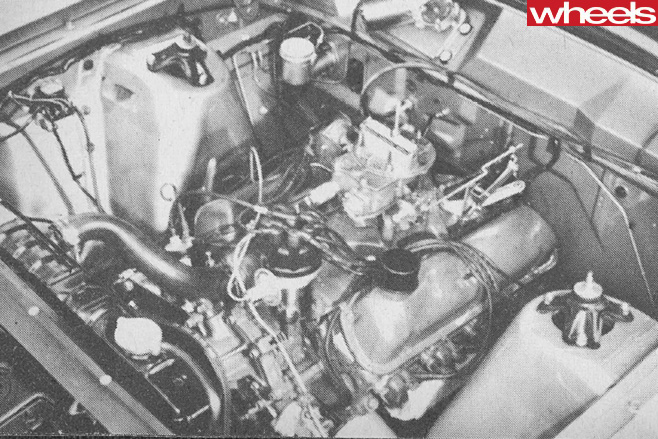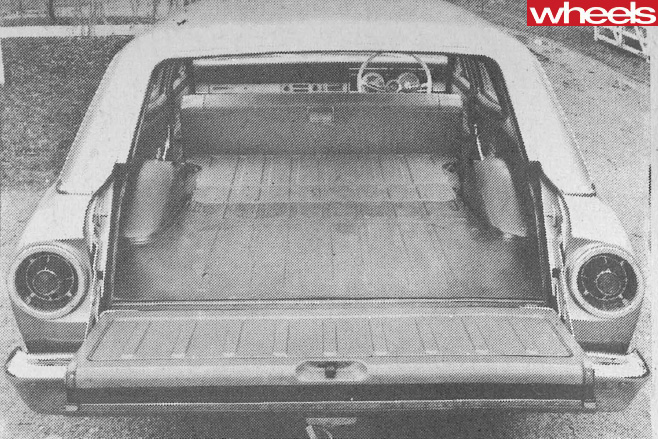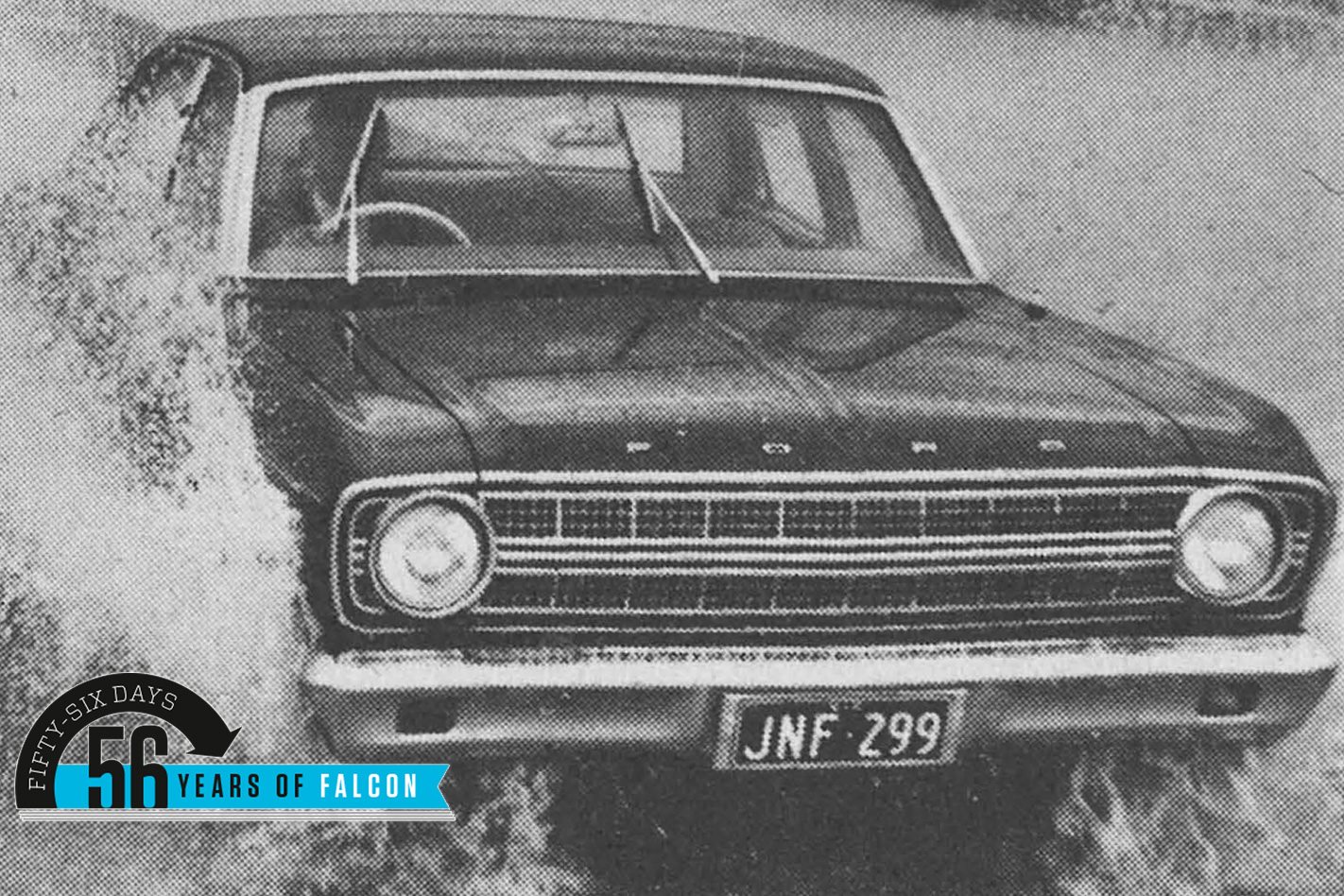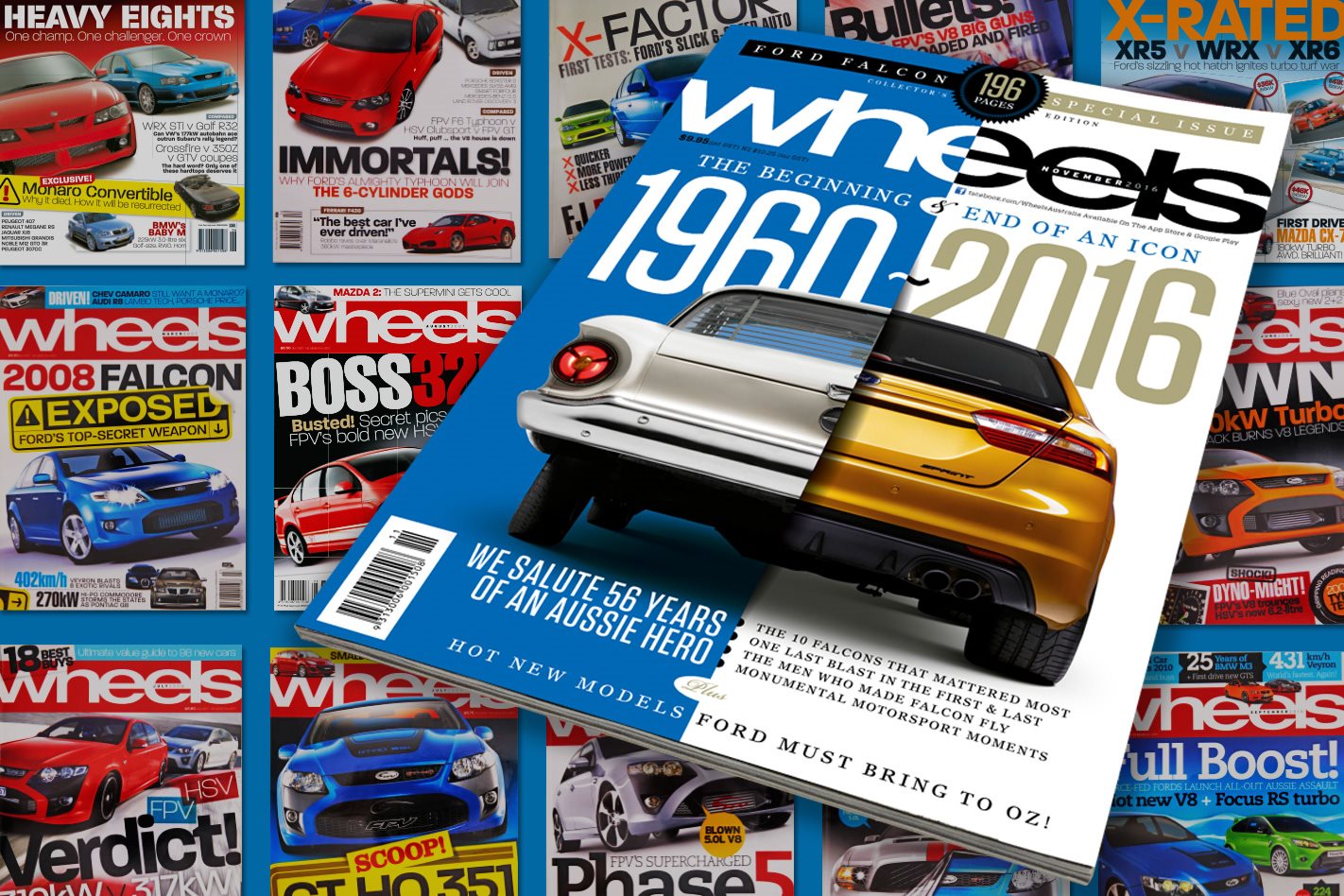Ford’s new XR Falcon has stolen a march on the opposition in the biggest possible way; we could be looking at the most influential new passenger car in Australia for years.
First published in the November 1966 issue of Wheels magazine, Australia’s best car mag since 1953.
THE new XR Falcon is undoubtedly one of the most important single steps ever in Australian automotive design. It is a huge pace forward, a dramatic new turn in our car development which puts us up there with the big ones in the world. The new model range is exciting, stimulating and different. For Australia it spells the start of a new size of car, and is the first car with which the V8 engine is available cheaply. If we’re any judge, Ford will soon be selling about 35 percent of Falcons with the V8 option.
The Ford Falcon XR, both in styling and engineering, is the product of all-Australian thinking for Australia’s unique problems. Its designers have tackled with resourcefulness and imagination the task of producing a car that out-thinks the Holden. They have come up with a beautiful mixture of bright new thought, advanced engineering, a wide option list and acceptable conventionality. It comes in the greatest variety of different forms of any Australian car so far and introduces some entirely new ideas to family motoring.

• All-new styling; with touches of Mustang and Zephyr.
• Three engine options, including new 2S9 cu in. V8.
• Three transmissions – one manual (optional all-synchromesh) and single and dual range automatics.
• Revised ride control by adjusted spring/damper rates.
• Bigger standard drum brakes, optional discs for all models, with optional servo assistance.
• Power steering on Fairmont models.
• Increased length, width, wheelbase, track, interior and boot room.
• Extended torque-box chassis design.
• Five-stud 14-inch wheels with low-profile tyres. Radial ply option.
• Decreased turning circle.
• Reduced driving effort through ·seating, steering, braking improvements.
• Bigger fuel tank (now 16.4 gallons) giving long cruising range.
• All-new interior trims and seating.
• Huge new option list (stereo tape is top of the list).
At least the first thing Australians will notice about the new Falcons is the very attractive styling. It is strongly similar to the American Falcon but actually features a better balanced line, using the Ford Mustang‘s Coke-bottle hip but abolishing the rear bias. The local Ford design engineers have achieved this simply and effectively in two steps: they increased the cabin size and extended the boot.
But there are important style changes in other respects. Chrome is kept to a minimum, and instead thin-line sheet metal mouldings are featured, although they are less pronounced than on the XP. The body mouldings actually bear a striking resemblance to those of the Galaxie and the whole formation of sheet metal on the car is done with an eye to strength and rigidity.

Ford’s aesthetics department set all the cars off with a neat slotted hub cap and added white-walls and a sill chrome moulding for the Fairmont. The 500 series – as the Deluxe is called – is decorated with a fine-line rubbing strip full length and the distinctive Falcon 500 bezel.
But the big news is engines. Falcon has really flung down the gauntlet by offering a V8 engine right through the range. Before, the cheapest V8 in Australia was Chrysler’s luxury Valiant, at $3550. The Falcon V8 is far cheaper. Ford’s 200 bhp 289 V8 engine is cheap to operate and is newer, lighter and more efficient than Chrysler’s 273. Chrysler will start building its engine here next year, but the Ford V8 will be imported for quite a while. But make no mistake – this country is now going V8!
At the other end of the scale Ford dropped the smallest engine of the old three-option range, the 144. This leaves the engine options at the 170, 200 and the V8. On the surface this is to enhance the power image but actually it goes deeper than that: the new XR is 300 lbs heavier than the XP. We feel Ford was worried that the combination of weight increase with the small engine would leave this combination underpowered. So Ford dropped it altogether, and made marginal alterations to the larger engines to compensate for the weight increase. The compression ratio is bumped up from 8.7 to 9.0 to 1, and the sixes also get seven main bearings and hydraulic tappets for smoother running and vibration and noise reduction.
The hydraulic tappets are new to the 170 only – the 200 had them last year. The only other change in this department is to revert to manual choke on both engines. The 289, however, keeps its American automatic choke. All engine compartments are now lockable, opened by an under-dash pull lever.
Ford took the improvement right down through the power train. The clutch for the manuals has grown from 8 1/2 ins. to a huge 9 1/4 ins. with a 14 percent frictional area increase from 68.1 ins. to 77.8 ins., AND it is now hydraulic. With the improved linkages this all adds up to smoother, more positive throws at the grarshift lever (still column mounted with no floor shift option). You can now get manual transmission with the 200 engine. There is a hint of that rattly change but it is not nearly as bad.
The gearbox has been beefed up right through. All the improvements are around the increased shaft centre design distance, enlarged from 2.7 to 3.0 ins., and this has brought the introduction of larger diameter gears, wider gear faces, bigger, sturdier shafts and bearings and a heavier casing. Built to order the manual gearbox is a snchromesh-on-first option.
The gearbox ratios have also been changed considerably, although the overall effect at the rear wheels is actually little different. On the manual shift first has been raised from 3.29 to 2.95 to 1 and the final drive ratio dropped from 3.2 to 3.50 to 1. The overall result is an increase at the differential from 9.528 to 10.325. The effect? Because of the increase in weight, it has slightly less acceleration through the gears, but the top speed is on a par with the old XP.

The same changes have been applied to the Fordomatic 38 three-speed single range automatic: slightly higher gearbox ratios with a lower tail ratio. The third gearbox is new to the Falcon range but not new to Australia. It is the dual-range Ford Cruise-o-matic box as used on the Galaxie. Fully imported, it is standard with the 289 cu in. V8 and optional on the 200.
The obvious question is what holds down all the power of the big V8? The answer contains the secret of success of the high torsional stiffness of the new Falcon XR. The torque box construction, introduced first with the 260 Fairlane and then the XP, has been extended drastically to cope with the XR’s increasing weight: the car has been built around the V8 engine.
There is a new torque box behind the gearbox mounting and the forward tubes extend right down the side of the gearbox to this point. They combine with the road shock-absorbing steel boxes at each wheel which are now insulated from the floor to give better isolation. Together they combine with the perimeter frame torque boxes to form an unusually rigid and torsionally stiff construction. Ford naturally didn’t want a separate production line just for the V8 option so all the sixes get the benefit of this new rigidity – designed to cope with the far greater torsional demands of the V8.
The legacies for all the models are ultra smooth operating conditions (the car feels much firmer) and for the sixes the old problems of gear linkage flexing are gone.
Getting all this power down onto the road wasn’t an easy task, but the engineering team came up with a near-perfect solution. Wheel size has gone up from 13 ins. to 14 on a five-stud construction. Low-profile tyres are fitted as standard and on the new safety rims they provide an additional variance to the overall gearing. Radial ply tyres are optional. There are three tyre size options. The six-cylinder cars can be ordered with either 6.45 by 14 or 6.95 by 14 tyres.
The V8 starts at 6.95 by 14 and has a 7.35 option. The wagons can also be ordered with the 7.35 tyre, so for the first time we have a “popular six” that isn’t under-tyred. Like the torque-box chassis design the whole suspension has been redesigned and beefed up to take the added power of the V8. Again this applies to all models, so you can say the new Falcon six is even sturdier than its predecessor. The main strength at the front comes from the box-section apron reinforcement but the wishbone gauge is heavier and the spindles are all much stronger. Coil spring weight has been increased. At the rear the leaf springs are longer, wider and have a higher load rating. In addition the rubber insulated spring-to-body mountings they feature the IsoClamp – a block of tensioned steel clamped to the spring to eliminate harmonics and vibration from the larger eyes used in the spring-to-body mounting.

This adds up to new dimensions in interior room. Shoulder room is increased by a massive 3 ins. to 57.1 ins. and hip room by nearly 3 ins. to 59.6 ins: Leg room stays the same (no increase in cockpit overall length) but head room in the front is decreased slightly by the higher seating position. The usable boot capacity also gets a big lift from 24.7 to 26.0 cu ft – mainly by moving the spare wheel from an upright position in the well, to a recess in the fuel tank under the floor mat. The fuel tank itself is increased by more than 40 percent to 16.4 gallons.
Obviously this is mainly to cater for the increased consumption of the V8, but like all the other improvements it stays for the sixes too, so you can expect a 300-odd mile cruising range out of these.
The brakes deserve a mention. Basic layout and design is unchanged but there are two important improvements: the disc brake option for all cars (previously standard Fairmont only), and the increased dimensions of the drums. For the sixes Ford offers a 10 3/4 in. disc of 1/2 in. thickness, but the V8 has its own special brakes – 11 in. diameter and ⅝ in. thick. Power assist is still standard on the discs.
Drum size has gone up from 9 in. diameter to 10 in., increasing friction area by almost 10 percent to 154.4 ins. We feel Ford has also made a slight alteration to the grade of bonded linings used as the brakes seem less prone to lock-up under severe conditions and the pedal action smoother and more and more positive, although pedal pressures are still too high. There is a notable increase in fade resistance, of course.
Steering ratio is virtually unchanged although the turning circle has a useful reduction from 38 ft to 36.6 ft. Actually the steering box internal ratio has been increased from 19.88 to 20.0 to 1 but overall ratio at the steering wheel stays at 27 to 1. We thought it would have been made more direct, and were very disappointed that it hasn’t. Power steering is an option.
One most noticeable feature of the XR is the concentration on interior quiet. The Falcon is now easily the quietest of the sixes and Ford is clearly trying to paint another Galaxie image in the medium class in this way. Apart from the normal sound absorbing material lavished on the roof, floors, doors and front wheels and rear compartments Ford hunted around for every likely vibration or sound trouble area.
Ford has described its interior as all-new, but this could be misleading. The basic layout of bench seats (reclining front buckets on Fairmont) is retained but a new trim and color range is offered. The dashboard is re-designed with smart new fine-line letter dials (the speedo still reads 120). However there are traces of the XP visible and all the controls stay in virtually the same places. The Deluxe cars – or where a heater is fitted – the temperature control selector is lit like the dashboard dials and automatic selector quadrant – quite a neat touch. Seating is better sprung with softer foam padding.
REMOTE CONTROL BOOT RELEASE
The option list is most impressive and carries some all-new devices for an Australian car. Top of the list must be the stereophonic tape system which turns your Falcon into a mobile sound lounge for a modest (we think) $136.32 including twin speakers. This unit is of the cassette type – and the whole tape comes ready-to-play in a tiny cartridge that can be changed blindfold. Another neat gimmick sure to be popular with Sydney’s taxi drivers is the remote control boot release. Operated by a small lever on the floor between the driver’s seat and door, this option costs $7.98. There are others of course – such as laminated and tinted windscreens, a shoulder sash option for the seat belts and dust deflectors for the station wagon tailgate, but there are three nifty gadgets we rather like. A stop lamp warning light installed on the dash tells the driver towing a caravan whether his stop lights are working properly; a woven nylon insect screen to combat the radiator clogging with insects is so small it can be rolled up and stored in the glovebox; and a special plexiglas windscreen protector is attached by only two points and makes a remarkably good seal with the windscreen surround to prevent internal misting.
HANDLING IS MUCH BETTER
Understanding-start acceleration on a variety of surfaces (and we even tried corrugations) the rear wheels spin briefly and then settle down to smooth take-up. There is little tail sway, axle-hop or wheel patter and no vibration transmitted through the car. This also applies to normal handling conditions. You can throw the car at the apex of any corner quite a bit too fast and scramble through with a controlled tail slide and an occasional fiddle with the throttle. This applies no less for the V8, though with the increased forward weight a heavier initial understeer tendency must be carefully controlled with the brakes, steering correction and throttle on exit. Neither car is vicious; though with the steering ratio some loss of sense of direction of the front wheels is possible in on-the-limit motoring. Back in reality the car behaves perfectly under normal conditions and on the V8 the average driver will note only a slightly heavier nose attitude, with pronounced weight transfer under braking. However, we would have preferred a more direct steering ratio. When you start working the car hard this lack of feel in the system starts to rear its ugly head.
Performance of the sixes is down a lot on the XP series – mainly due to the weight penalty. Even careful choice of gear and final drive ratios couldn’t remedy that. But right at the top end of the scale speeds are little different.
The V8 is little short of shattering. The get-up-and-go acceleration is instant and effortless, without tossing the occupants around unduly. The car winds smoothly and quickly right to 110 mph. Under high-speed cornering the understeer tendency is pronounced, but on medium or low speed corners the car behaves little differently from the sixes.
For outright performance we would pick a V8 fitted with four speed all-synchromesh manual shift. But maybe we want too much.
NEW FORDS: SIX MONTHS AGO
WE peeled the covers off the XR Falcon in April WHEELS. This detailed the true inside information on the new Australian Falcon.
Here’s how we saw it then – exactly as released on the Australian market today just six months later.
For a start we nominated the exact styling from random photographs of dosely counterfeited models, the release date, the number of engines (including the new V8), alterations to suspension, chassis and dimensions and an almost complete list of options. We said the car would closely resemble the American Falcon with the only major alteration to the concept being an extended boot to suit the demands of the Australian motorist. We summed up the external differences as being wider, and longer (both in suspension and body) and lower.
We also said the main dimensional difference between the Australian Falcon XR and the American Falcon and Mustang from which it is derived would be increased boot capacity.
The relative figures are 7.7 cu ft for the Mustang, 12.5 for the US Falcon, and 26 for the XR.
Here is a list of other points we predicted accurately:
- Manual shift for 200 six engine.
- Minimum of body brightwork.
- Seven bearings for the sixes.
- Change to 14 in. wheels. Use of low profile tyres.
- Basic tyre size up from 6.50 to 6.95.
- All new interiors.
- Vinyl roof option.
- Full width facia padding, swept-away dash.
- Laminated screen, tinted glass options.
We also said the steering would be geared up from 5.5 turns lock to lock to about 4.25 turns. This hasn’t happened; but the box ratio itself has been altered.
After this one, it is harder to imagine a better Falcon – but that is already being planned. Watch for the first news in WHEELS. As usual.
Check out Wheels Archive online now for other great Ford Falcon features and more from decades past!
Simply log in here using your existing MagShop account or create a FREE account and select this article from the homepage.
Don’t have a MagShop account?

Have a MagShop account?






